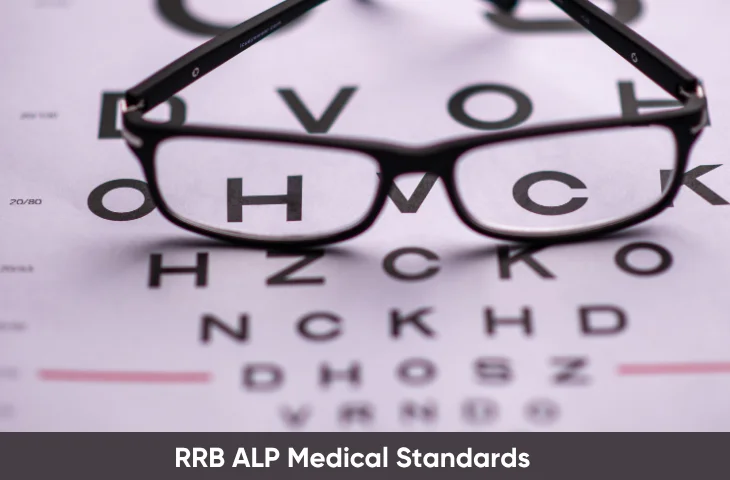The RRB ALP Medical Standards are a crucial component of the recruitment process for the Assistant Loco Pilot (ALP) position in Indian Railways. After clearing the RRB ALP CBT 2 and Aptitude Test, candidates must undergo a thorough medical examination to ensure they are physically and medically fit for the demanding role of a loco pilot. This article explains the medical standards, eye test requirements, and important tips to prepare for the medical fitness test in 2025.
Understanding the Importance of RRB ALP Medical Standards
Being an ALP requires constant vigilance, quick reflexes, and excellent physical and visual health. Railway authorities strictly enforce medical criteria to ensure safety for both the candidates and passengers. As per the RRB ALP Notification, the medical examination evaluates:
- Vision and eye health
- Hearing ability
- Cardiovascular fitness
- Musculoskeletal fitness
- Overall physical and mental health
RRB ALP Medical Examination Components
The medical examination for RRB ALP includes multiple checks designed to assess a candidate’s overall fitness. The main components are:
| Components | Details |
| Vision Test | Distant and near vision, color vision, field of vision, depth perception |
| Hearing Test | Ability to hear normal conversation and warning signals |
| Physical Examination | Height, weight, chest measurement, general health assessment |
| Cardiovascular Test | Heart, blood pressure, and overall cardiovascular fitness |
| Musculoskeletal Test | Limb functionality, joint movements, spine health, muscle strength |
| Laboratory Tests | Blood, urine, and other routine lab tests |
RRB ALP Eye Test Requirements
Vision is one of the most critical parameters for ALP candidates. Below are the key eye standards:
| Parameter | Requirement |
| Distant Vision | 6/6 (each eye separately) with or without correction |
| Near Vision | J1 (each eye separately) with or without correction |
| Color Vision | Normal color vision required (Ishihara test) |
| Field of Vision | Normal (both eyes) |
| Binocular Vision | Normal depth perception required |
| Eye Diseases | Candidates must be free from squint, night blindness, glaucoma, cataract, or any other chronic eye disease |
Common Conditions That May Lead to Disqualification
Railway authorities are strict about medical fitness to ensure operational safety. Conditions that may disqualify a candidate include:
- Severe myopia or hypermetropia beyond permissible limits
- Color blindness or impaired depth perception
- Cardiovascular disorders such as hypertension or arrhythmia
- Hearing impairment affecting alertness
- Musculoskeletal deformities impacting mobility or control
Tips to Prepare for RRB ALP Medical Examination
The RRB ALP Preparation Tips for the medical examination are given below. Follow these tips to qualify for the test:
- Regular Eye Check-ups
- Ensure vision is corrected to meet RRB standards.
- Avoid straining eyes before the test.
- Maintain Physical Fitness
- Cardiovascular exercises like walking, jogging, or swimming.
- Strength training for musculoskeletal fitness.
- Balanced Diet
- Include vitamins and minerals to maintain vision and overall health.
- Avoid excessive caffeine or alcohol before the medical test.
- Hearing Care
- Avoid prolonged exposure to loud noise.
- Consult an ENT specialist if minor issues persist.
- Documentation Ready
- Carry medical reports, prescriptions, and corrective lens details.
Summary of RRB ALP Medical Standards
A summary table discussing the key points of RRB ALP Medical Standards is given below:
| Medical Parameter | Requirment | Remarks |
| Distant Vision | 6/6 each eye | With or without correction |
| Near Vision | J1 each eye | With or without correction |
| Color Vision | Normal | Ishihara test required |
| Depth Perception | Normal | Binocular vision essential |
| Field of Vision | Normal | Both eyes tested |
| Height & Weight | As per Railways norms | BMI in normal range |
| Hearing | Normal | Should hear normal conversation & warning signals |
| Musculoskeletal Fitness | Normal limb & joint function | No deformities or restrictions |
| Cardiovascular Health | Healthy heart & BP | Free from chronic disorders |
The RRB ALP Medical Standards are designed to ensure that only medically and physically fit candidates are entrusted with the responsibility of operating trains. Candidates must focus on maintaining good vision, hearing, and overall physical health, and be aware of all requirements before the medical examination. Proper preparation, regular check-ups, and a healthy lifestyle can significantly increase the chances of passing the medical fitness test in the first attempt.
FAQs
Candidates must have 6/6 distant vision and J1 near vision in each eye, with or without corrective lenses. Normal color vision, depth perception, and a full field of vision are mandatory. Conditions like color blindness or severe myopia may lead to disqualification.
Yes, candidates with minor myopia or hypermetropia can qualify if vision can be corrected to meet the standard. Corrective lenses are allowed, and any laser eye surgery should be at least 6 months old with stable vision.
Apart from vision, the medical exam evaluates hearing ability, musculoskeletal fitness, cardiovascular health, height and weight, and general physical and mental health to ensure the candidate can safely operate a train.
Candidates may be disqualified due to color blindness, impaired depth perception, severe vision defects, hearing impairment, musculoskeletal deformities, or cardiovascular disorders affecting safety and alertness.
Preparation includes:
Regular eye and hearing check-ups
Maintaining cardiovascular and musculoskeletal fitness
Balanced diet with vitamins and minerals
Avoiding strain on eyes and ears before the test
Carrying all relevant medical records and corrective lens prescriptions
- रेलवे परीक्षा की तैयारी करें, सारी जानकारी यहां देखें
- Loco Pilot Salary in India 2025, Know Salary Per Month
- Important GK Questions in RRB ALP Exam, Download Free PDF
- RRB ALP Important Topics 2025, Check CBT 1 Topics
- A Complete Analysis of RRB ALP CBT 1 vs CBT 2 vs Aptitude Test
- RRB ALP Online Application 2025, Know Steps to Modify

Hello! This is Arijit Dutta. I am a skilled Content Writer at Oliveboard with nearly 3+ years of experience in crafting engaging, informative, and exam-focused content for the Railways Domain. With a strong command of language and a keen understanding of learner needs, I contribute significantly to Oliveboard’s mission of delivering high-quality educational resources. Passionate about clear communication and continuous learning, I consistently create content that helps government job aspirants achieve their goals. Outside of work, I enjoy playing cricket and listening to music, which helps me stay balanced and creative in my professional journey.
